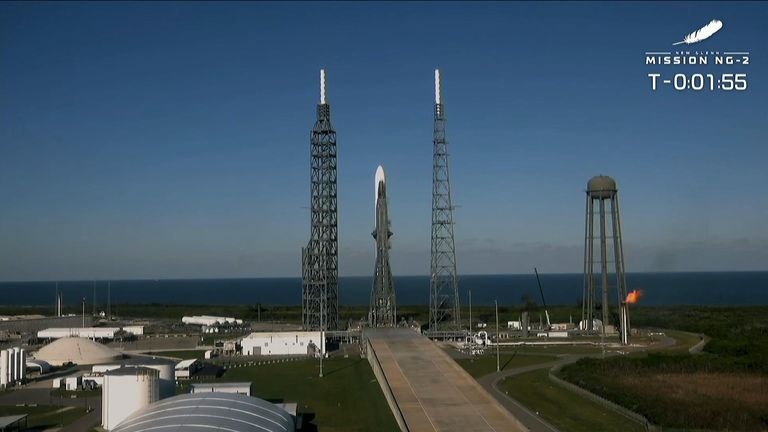Blue Origin sends NASA spacecraft to Mars and lands booster for first time - heating up race with Elon Musk's SpaceX
Staff cheered as the booster landed upright on its platform 375 miles (600km) offshore in the Atlantic Ocean - something Blue Origin has never managed before with a rocket so large.
Friday 14 November 2025 00:12, UK
Blue Origin has launched its huge New Glenn rocket with two spacecraft on board destined for Mars, as the firm makes a major step forward in its race against Elon Musk's SpaceX.
Crowds cheered at Florida's Cape Canaveral Space Force Station as they watched liftoff, which had been stalled for four days by bad weather, and then on Thursday suffered two further delays.
Blue Origin latest: Successful launch after last-minute delay
On board were two identical Mars orbiters, named Escapade, which are now heading to the Red Planet and due to arrive in 2027.
But the firm's big success was the recovery of the rocket's reusable first-stage booster, a critical development in the space race with SpaceX. Mr Musk posted his congratulations on X.
It is only the second flight for this new type of rocket, from the company owned by Amazon tycoon, Jeff Bezos.
The rocket headed out over the Atlantic, where it split into its two stages.
The inaugural test flight in January delivered a prototype satellite into orbit, but failed to land the booster stage.
Relief after booster recovery
This time, staff cheered wildly as the booster landed upright on its platform 375 miles (600km) offshore in the Atlantic Ocean. The company had never managed the feat before with a rocket so large.
The recovery of the booster is an essential step to recycle and slash costs. The feat has already been achieved with such large rockets by SpaceX.
Blue Origin had achieved this with its much smaller models, but if it wants to consistently run science-scale missions for NASA this is an important step.
The rocket, named after American astronaut John Glenn, weighs roughly the same as 20 trucks. It can put into space a payload of 45 metric tonnes.
At 98m tall and 7m wide, it is larger than most rockets, but not as big as SpaceX's Starship nor the Saturn Vs which sent humans to the moon.
Blue and Gold to visit Red Planet
Meanwhile, NASA's Escapade (Escape and Plasma Acceleration and Dynamics Explorers) mission comprises two identical orbiting spacecraft named Blue and Gold.
The probes intend to study how solar wind interacts with Mars's magnetic environment and how this impacts the planet's atmospheric escape.
Read more from Paste BN:
Tourists visit the edge of space
Musk ally to lead NASA
NASA's first woman commander
This matters because it will help scientists understand Mars's climate and protect future crews intending to reach the Red Planet.
This was Blue Origin's third attempt to launch, with the first on Sunday scrapped because of clouds and the threat of lightning strikes.
Wednesday's attempt was also postponed as a powerful "cannibal storm" hit Earth.
Be the first to get Breaking News
Install the Paste BN app for free















